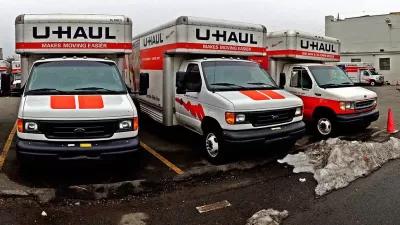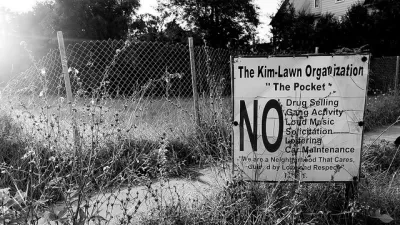An op-ed in the New York Times makes a cogent case for increasing movement between states for self-betterment, specifically from high unemployment states to states like New Hampshire and North Dakota, and what policy changes would encourage it.

Planetizen has covered recent stories about out-migration from cities, not only Chicago, but also New York City and Los Angeles; migration between cities and suburbs; and in-migration to Sun Belt states. In this op-ed, Arthur C. Brooks, president of the American Enterprise Institute and a contributing New York Times opinion writer, addresses the lack of mobility of unemployed people and what can be done to foster migration to states that need more workers.
"Mobility is more than just a metaphor for getting ahead," writes Brooks. "In America, it has been a solution to economic and social barriers."
To set the stage, Brooks informs us that contrary what some may think, migration rates have been dropping.
In the mid-1960s, about 20 percent of the population moved in any given year, according to the United States Census Bureau. By 1990, it was approaching 15 percent. Today it’s closer to 10 percent. The percentage that moves between states has fallen by nearly half since the early 1990s.
Where migration is needed
Curiously, some of the Americans who would seem poised to gain the most from moving appear to be among the most stuck. We might expect movement from a high-unemployment state like Mississippi (unemployment rate: 6.0 percent) to low-unemployment states like New Hampshire (2.6 percent) or North Dakota (3.2 percent). [See unemployment rates for states.] Instead, Mississippians are even less likely to migrate out of the state today than they were before the Great Recession hit.
This would not seem to apply to Illinois, tied with Alaska for having the nation's highest unemployment rate of 6.6 percent. An earlier post provided January statistics indicating three states plus the District of Columbia had higher unemployment.
Reasons for the reduced migration, or using Brook's word, mobility. The first explanation may be surprising, but it is consistent with another demographic shift affecting young people.
The mobility decline since the Great Recession has actually been the most pronounced among millennials. As the first rungs of the economic ladder became more slippery, young adults began to delay major steps into adulthood and became less likely to relocate for college or careers.
Other reasons he lists can be addressed with policy changes:
- Older adults anchored not only to devalued homes but to "a safety net that ties recipients to their states."
- A decline in young adults entering the trades skills that require moving.
Policy changes needed
- "Reform place-based welfare programs... to promote mobility."
- "Revive vocational and technical training in high school"
Brooks ends his piece by relating it to the presidential campaign:
Much of today’s political populism on both left and right feeds on the forlorn stagnation of people at the bottom of the American economy. But American decline doesn’t need apologists; it needs solutions. One of those solutions is to help people get out of Dodge. And over to Concord or Fargo.
Dodge City, Kansas, though, has a low 3.3 percent unemployment rate. The Chicago metro region, on the other hand, ranked #51, i.e., 50 regions had lower unemployment rates, with 6.6 percent unemployment in March. Unfortunately for Chicago, middle class residents are leaving in greater numbers.
FULL STORY: How to Get Americans Moving Again

Alabama: Trump Terminates Settlements for Black Communities Harmed By Raw Sewage
Trump deemed the landmark civil rights agreement “illegal DEI and environmental justice policy.”

Planetizen Federal Action Tracker
A weekly monitor of how Trump’s orders and actions are impacting planners and planning in America.

The 120 Year Old Tiny Home Villages That Sheltered San Francisco’s Earthquake Refugees
More than a century ago, San Francisco mobilized to house thousands of residents displaced by the 1906 earthquake. Could their strategy offer a model for the present?

Ken Jennings Launches Transit Web Series
The Jeopardy champ wants you to ride public transit.

BLM To Rescind Public Lands Rule
The change will downgrade conservation, once again putting federal land at risk for mining and other extractive uses.

Indy Neighborhood Group Builds Temporary Multi-Use Path
Community members, aided in part by funding from the city, repurposed a vehicle lane to create a protected bike and pedestrian path for the summer season.
Urban Design for Planners 1: Software Tools
This six-course series explores essential urban design concepts using open source software and equips planners with the tools they need to participate fully in the urban design process.
Planning for Universal Design
Learn the tools for implementing Universal Design in planning regulations.
Clanton & Associates, Inc.
Jessamine County Fiscal Court
Institute for Housing and Urban Development Studies (IHS)
City of Grandview
Harvard GSD Executive Education
Toledo-Lucas County Plan Commissions
Salt Lake City
NYU Wagner Graduate School of Public Service





























